In an abandoned gravel pit on the outskirts of the small Ontario farming community of Carp (just west of Ottawa) strange things were happening. It was 1959 and over the next two years this site was transformed into one of Canada’s primary Cold War secret defence facilities. A few months earlier Prime Minister John Diefenbaker had risen in the House of Commons to make this announcement: “…development of a decentralized federal system of emergency government with central, regional and zonal elements would proceed” (Hansard, Aug 21, 1958)
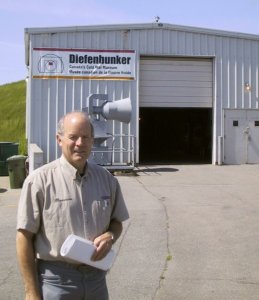
Mr. Diefenbaker went on to describe the basic principles of what became known as the Continuity of Government Program. These principles in effect set up a framework for the protection and support of key government elements in case of massive nuclear attack on North America. Small numbers of elected federal and provincial representatives along with supporting officials were included in this program. While generally calling for these people to be evacuated from risk areas and be able to run on a decentralized basis. There was recognition of Ottawa’s particular vulnerability to direct attack by a manned bomber carrying up to a five megaton nuclear weapon and the need for some degree of protection against blast and the other direct effects of such a weapon. Over the next decade a system of up to 50 protective shelters were put in place across the nation. The Department of National Defence was given the responsibility to build and run seven of the most advanced shelters. The facility at Carp was the “flagship” as it was also resistant to high levels of blast ( the equivalent of 5 million tons of TNT exploding at about a mile away) compared to the all of others which were only designed to protect against fallout. Shelter in the Central Emergency Government Facility was provided for 535 people for up to 30 days
The Diefenbunker, as it is known in conversation, was designed and constructed by The Foundation Company of Montreal. Construction supervised by the army, with Lieutenant Colonel Ed Churchill, (Royal Canadian Engineers) as the project manager. A number of significant technical achievements accomplished in realizing this project, two are particularly notable.
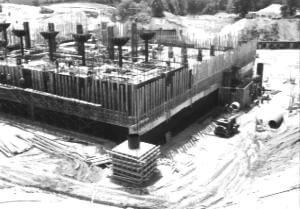
Due to the lack of a suitable, nearby massif of hard rock, the usual approach to building a shelter to resist the direct effects of a nuclear weapon which consisted of tunnelling into and hollowing out a granite mountain could not be followed. Instead the designers built a monolithic heavily reinforced high strength concrete “box” and surrounded it with a 5-foot thick pad of compacted, well-drained gravel. The facility’s roof and base slabs are 5 foot thick and are 154 feet on a side. Thirty-six 4.5- foot diameter columns at 22 feet centers carry the blast load from the roof slab through four levels to the base. The column shear heads and bases flare out to 10 feet diameter and are specially reinforced with thick steel plates welded to large rolled steel H-sections that run down the center of each column. The walls of the building range from 2.5 feet to over 4 feet thick. This strength as needed to make sure that the facility could survive a 5-megaton ground detonation at 1.1 miles from ground zero. At such a distance the blast over pressure would have been over 100-psi and the “wind” passing over the structure would have exceeded 1000 mph!
The second significant achievement concerns the project management technique used to bring the project in on time and on budget. A “handrualically” operated version of the then new Critical Path Method – CPM (a graphical network analysis tool had first been used by the US Navy to build nuclear submarines) was used extensively to control the very complicated materials and labour “flow” in the confined spaces of the facility. In the early 1960s CPM had only recently been added to the training of Young Officers courses at the Royal Canadian School of Military Engineering in Chilliwack, BC. A few years later CPM had evolved considerably, becoming much more advanced eventually being replaced by other project resource control systems (such as PERT). In any case CPM was used with great success during the construction of the Carp bunker.
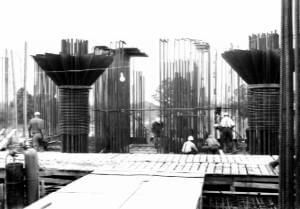
Over 32,000 tons of concrete and 5000 tons of reinforcing steel (much of it reinforcing bars of 2 ¼ inch diameter!) were used in constructing the main facility at Carp and the transmitter site 20 miles away in a similarly constructed but much smaller building near Perth, Ontario. At one time over 1000 workers were employed on the site. The project cost $20 million (not including the special electronic telecommunications equipment installed in 1962-3).
While not a special innovation of this project, the constricted spaces within the bunker led the designers to borrow a technique used often by ship designers of the day. They constructed a very accurate and detailed large-scale model of the facility. This enabled them to fit-in all the intricate plumbing, ducting, cabling and machinery required to support the environmental and functional equipment necessary for the operation of the facility. The model was a main “feature“ of the Station Officer’s lounge during the 33 years that of CFS Carp’s operational existence. It remains a popular exhibit for visitors to the museum to view during their tour of the facility, enabling them to acquire a better comprehension of the structure.
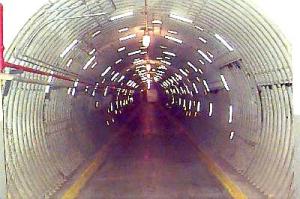
Originally the project was known as Project EASE (for Experimental Army Signals Establishment). While there was a grain of truth to this, the title was primarily a cover to obfuscate its real purpose; that of being a place for small group of federal government elected and selected supporting officials (535 civilian and military) to survive and to attempt to carry on governing the nation even in the face of a nuclear attack on the continent. In reality it was a very badly kept secret. A local journalist flew over the stores layout area and counted the toilets (still in their packing cases in the stores layout area), and concluded that 78 for the 150 men that were supposed to use the building for its stated purpose, was a bit odd! He published his conclusions in a Toronto newspaper much to the extreme annoyance of Prime Minister Diefenbaker who at this stage in the construction was trying to down play his government’s role in such matters as much as possible.
In reality the bunker was part of an extensive system of shelter facilities for various levels and elements of government across the Canada. Most provinces eventually had what were called “Bridge” sites where shelter from radioactive fallout was provided for 250 and 350 provincial and federal officials (including military experts). They would have been responsible for directing efforts to coordinate survival operations in support of that province’s people.
Throughout its years of operation the Carp bunker (and many of the bridge sites) also served an alternate and very much a complementary (to its main purpose) role; that of a main node in the military national strategic telecommunication’s system. While doing this DND also maintained the various facilities in a reasonable state of readiness and, in concert with their civil defence and emergency measures counterparts, tried to make sure that they would be ready for the government should they ever be needed
Civil emergency preparedness officials ceased their responsibilities in the bunker in the fall of 1992 and the DND decommissioned the Carp site in December of 1994. The original plan seems to have been to strip the building of anything useful and then seal it. Fortunately officials of West Carleton Township, urged on by a group of local volunteers took a good look at the potential of the facility from the viewpoint of its historic value. The township acquired the site and all of its structures (along with some environmental cleanup obligations) for under $300,000. Unfortunately by the time the paperwork was done, most of the interior furniture and equipment had been removed and sent to the dump or Crown assets for disposal. On the other hand, happily, efforts made to acquire similar furniture from some of the other DND bunker facilities have been successful. This furniture and equipment is being used to recreate many of the rooms, working spaces and special offices that were part of the bunker during most of its operational life.
Part of the station’s original 80 acres have been converted into a baseball diamond. A recently completed exterior Construction Engineering building (completed just two years before the facility was closed) has been renovated as the local library. In June of 1998 the bunker and some of the land surrounding it was declared a National Historic Site by Heritage Canada. Unfortunately this honor does not come with real funding but the moral and advice support is quite helpful. While the bunker was acquired from the township by the same small group of dedicated volunteers for about $3.00, its electrical bill alone runs over $3500 per month (not to mention all the other maintenance expenses required to keep a 100,000 square f00t four-story underground building operating in a way that provides comfort and safety to the occupants and protects its valuable artifact and archival contents. Fortunately public tours have been quite successful to date, providing 75% of the revenue needed to keep things going. The City of Ottawa also helps with a $50,000 annual grant. That, in concert with a few of the civil staff who managed the building’s environmental and telecommunications systems during its working years and who have since retired have been a great help in maintaining and operating the facility. Recently there has been an influx of volunteers with the right motivation and skill sets. As well a full-time Curator and assistant have greatly added to the long-term viability of the Museum .
Last year over 25,000 people took two-hour guided tours of the building and seemed to really quite enthralled by their experience. Ages ranged from 8 to 80. Many of the building’s areas are being restored to something like their working condition (the PM’s Suite, the Emergency Government Situation Centre, the CBC Emergency Broadcasting Studio, the Military Federal Warning Centre, the External Affairs Ministerial Office, the Public Works Minister’s Office and the Bank of Canada Vault, to name a few). Other of its 358 rooms have been converted to relevant exhibits of the Cold War era, including Civil Defence Shelters and the atomic bombing of Hiroshima with many more in the works as time, ability and funds permit. Our goals include educating the present and future generations about the Cold War as well as (eventually) providing artefact and archival material for future researchers. At Present we have over 3000 books in our nascent library plus rooms full of yet-to-be-sorted files, photos, blueprints and other documents from the Cold War era.
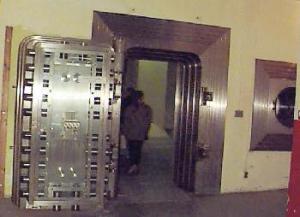
We are learning to “partner” extensively with government agencies (i.e. Heritage/Parks Canada, National Defence) educational institutions (i.e. Algonquin College) and a number of private sector firms who have supported us with some funding, advice, materials and equipment. As well we benefit greatly from our group of willing and able volunteers who devote countless hours to keeping the project going. We do need more help especially with respect to hands-on building operation and maintenance, archives and library duties and with the construction of exhibits.
If you would like to learn more about the Diefenbunker or would like to look into becoming a volunteer or have knowledge that we should acquire for our archives please contact the Diefenbunker at 613 839-0007 or 1 800 409-1965.
Bruce’s note: I actively sought out this story. It may seem to some as an advertisement for the Diefenbunker and it is. A group of volunteers got together to keep and display an important part of our heritage that many of us have forgotten or just not known. Visit the bunker, volunteer to help them or support them with donations. This place deserves our support. Thanks to Dave and the Board at the Diefenbunker.
And finally, in a bit off self promotion, watch for my new book, available in spring 2012. This, yet untitled, mystery drama will take place in the Diefenbunker, the NORAD Underground Complex, in the far Arctic of Canada, in the skies of Cold War Europe and the skies over Israel.
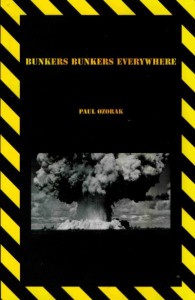
While many books have been written about the Cold War, few have provided detailed information about the many physical establishments created to survive or fight this conflict. “Bunkers Bunkers Everywhere” fills this gap by describing such places as command posts, government continuity-of-government bunkers and missile silos that were built underground with the realization that they would be most able to withstand a nuclear war. Now that the threat has receded, however, much can be learned about these places as the veil of secrecy has often been lifted. The book is broken down into chapters for:American Bunkers, American ICBM Bases, American SAM Sites, Canadian Bunkers, British Bunkers, Other National Bunkers and Russian FacilitiesAlso included are appendixes on US ICBM sites, US SAM sites, British bunkers, and a list of Canadian “Diefenbunkers.”The book would be a great companion to anyone wanting to visit the Diefenbunker.
Dave Peters
wilfred nicholas
trying to locate DAVID PETERS
River Boat
Dave lives in Manotick Ontario.